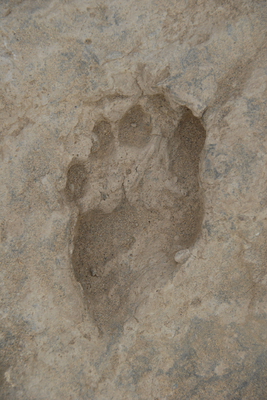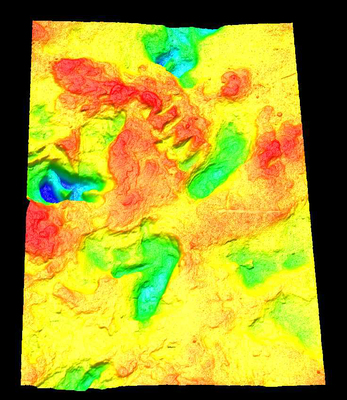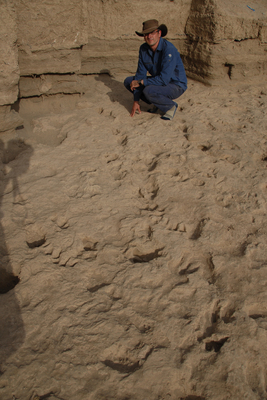
by Mary Caperton Morton Thursday, January 5, 2012

Fossil footprint, likely left by _Homo erectus_, found in Kenya. Image courtesy of Professor Matthew Bennett, Bournemouth University

An optical laser scan shows three footprints from the _Homo erectus_ footprint trail mixed with a range of other animal prints. Image courtesy of Professor Matthew Bennett, Bournemouth University

Bennett with the trail of fossil _Homo erectus_ footprints in northern Kenya. Image courtesy of Professor Matthew Bennett, Bournemouth University
In the Great Rift Valley in northern Kenya, researchers have discovered a cluster of footprints that look almost exactly like those you or I might leave on a sandy beach. These prints, however, were left by early hominins more than 1.5 million years ago, making them the oldest known evidence of fully modern bipedalism.
Anatomical adaptations for bipedalism appear in the hominin fossil record as early as 6 million years ago, but the timeline of when and how our modern walking gait evolved is a matter of considerable debate, says Matthew Bennett, an expert on trace fossils at Bournemouth University in Poole, England, and lead author of the paper published tomorrow in Science.
Part of the problem is that preserved hominin footprints, which provide unique evidence about gait, are exceedingly rare. “We have one set of prints from 3.6 million years ago and now we have one set from 1.5 million years, and that’s it,” says Briana Pobiner, a curator for the Human Origins Program at the Smithsonian National Museum of Natural History in Washington, D.C, who has also studied this region of Kenya, but was not involved in the new discovery.
The older prints, found at the Laetoli site in Tanzania by Mary Leakey in 1978, are attributed to Australopithecus afarensis. Although those footprints suggest that A. afarensis also walked upright, they show a much more primitive foot and gait with a splayed big toe and flatter arches. The more recent prints, attributed to Homo erectus, “look remarkably like a modern footprint,” Bennett says, with the big toe in line with the axis of the foot, a robust heel bone and a pronounced arch.
Bennett and colleagues uncovered three footprint trails — the longest with seven prints — in a flood plain deposit along the northeast shore of Kenya’s Lake Turkana. “It’s difficult to determine how many people were walking, but there seem to be several individuals and at least one sub-adult present,” Bennett says. By estimating height and weight based on the size of the prints, the team determined the tracks were probably left by tall, lean Homo erectus, as opposed to Homo habilis or Paranthropus boisei, two shorter, more robust hominins that also lived in this region during the same time period.
“It’s not really a surprise to find evidence that modern bipedalism dates back 1.5 million years,” Pobiner says. “We already knew from Turkana Boy [a largely complete Homo erectus skeleton discovered on the west shore of the lake in 1984] that Homo erectus had nearly modern body proportions,” she says, “but this is outstanding confirmation that they walked just like us too.”
© 2008-2021. All rights reserved. Any copying, redistribution or retransmission of any of the contents of this service without the expressed written permission of the American Geosciences Institute is expressly prohibited. Click here for all copyright requests.